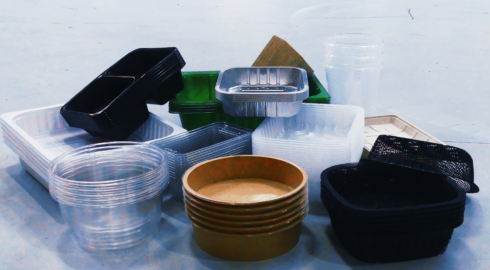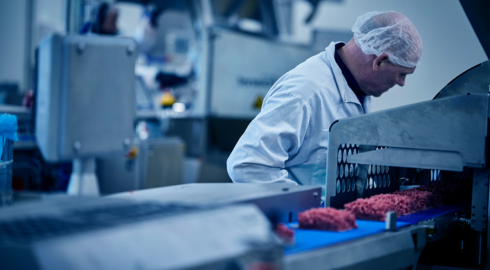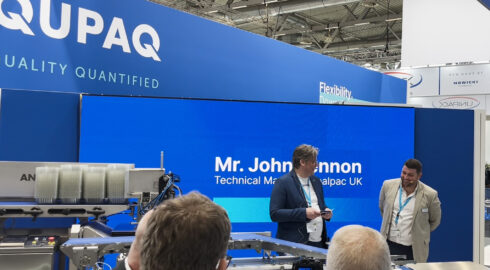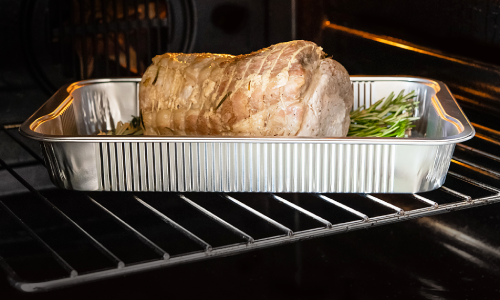
How Would the Perfect Tray Look?
Design for Automation makes sense, and if it will allow for fewer processes, higher speeds and capacity, less cost for logistics and supply chains and reduce the risk of downtime significantly – not just slightly – we can evolve.
Design for Automation
There is a reason why food gets delivered in trays. Trays are cost-effective and increasingly environmentally friendly. And they prolong the foods end-date, which again lowers the impact on the climate. Trays are not about to be replaced, not even if moulding technology finds it ways into the production lines also – that’s just another risk factor for downtime, if we keep adding more processes into the line.
Trays are an efficient, proven and sound solution for Food Packaging. But still not perfected. There are tens of thousands of tray variants in use today. Different sizes, materials and shapes. A tray should of course be designed for the product it should contain. Cheese slices and ready-meal packaging are two different scenarios altogether.
Also read:Let’s Keep it Clean in Here
And defining the product is where the value chain often kicks off. Food Manufacturing starts with the product, then looks for the trays to put the product in. And lastly, look for the technology to denest the trays and load the products into them, before sealing and handling the packages preparing them for shipment.
But what if we changed the value chain a bit? What would happen if the tray was designed for automation and denesting first, and the product secondary?
Of course, the tray should honor and uphold the same level of hygiene and keeping the product just as fresh as it normally would. But could cost efficiency be pushed even further?
Tray Characteristics
QUPAQ have evaluated thousands of trays from all over the world. We offer both the Food Industry and Tray Manufacturers to send us trays for benchmarking on INTRAY and ANYTRAY denesters. We keep all this data to analyze and innovate our denesting technology further.
Let us evaluate your trays: Evaluation form
The tray material is important to consider when designing an optimal automated production line. Food for heating (ex. chicken) will often get placed into aluminum trays. Aluminum is difficult to denest – although QUPAQ does this successfully, the material itself puts some limits on the capacity. Running at top speed could rip the trays apart. No real alternative has been found that offer the same features. But aluminum should be used with care – trays are getting increasingly expensive to use and we do see more chickens end up in recycled PP trays instead.
The size of the trays matters less. The main consideration is to keep the air between tray and product as low as possible. I.e., the tray must never be oversized. Some food has various sizes and shapes, and these variations should leave some tolerance in the tray size.
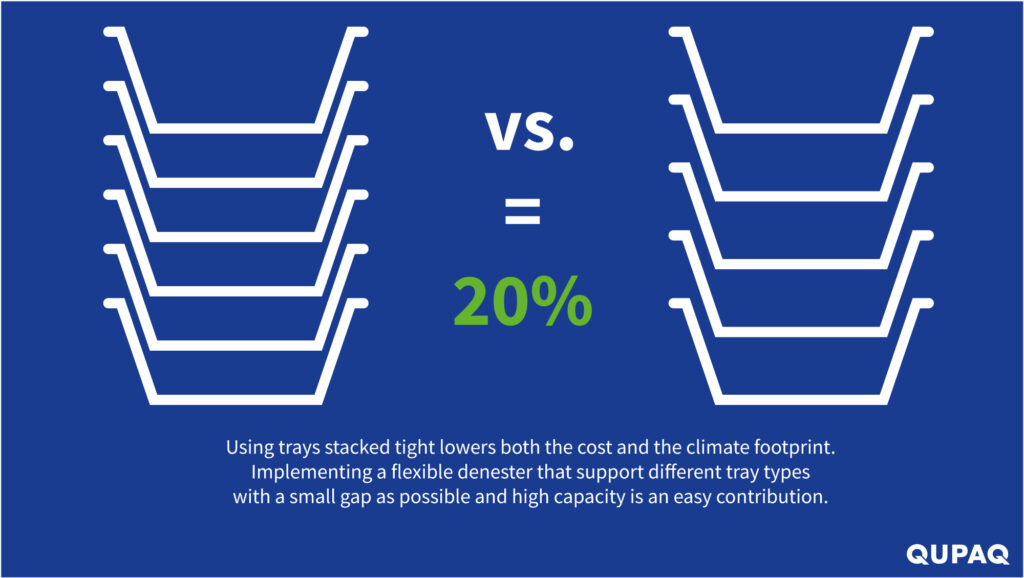
The best optimization to look for is keeping the nests tight. Getting as many trays stacked as closely together as possible to minimize the cost in logistics when moving what is basically air around. Low gap configurations of denesters are difficult but getting increasingly better all the time. QUPAQ have successfully made solutions with less than 1mm. gap between nested trays. This could perhaps get even lower, if trays were designed for this purpose.
The Edge
There are many variables to consider when designing the best tray possible. Trays are designed for various product weights to uphold its structural integrity. Some trays have very thin edges whereas others have shaped and moulded edges.
The edge of the tray is important from a denester perspective, as this is where the nested trays get ‘sliced’ and separated one by one. A thin sharp edge with trays stacked too tight doesn’t leave much room for the slicer. If the edge was rounded a little bit, the slicer and sensors could better detect and tell the trays apart.
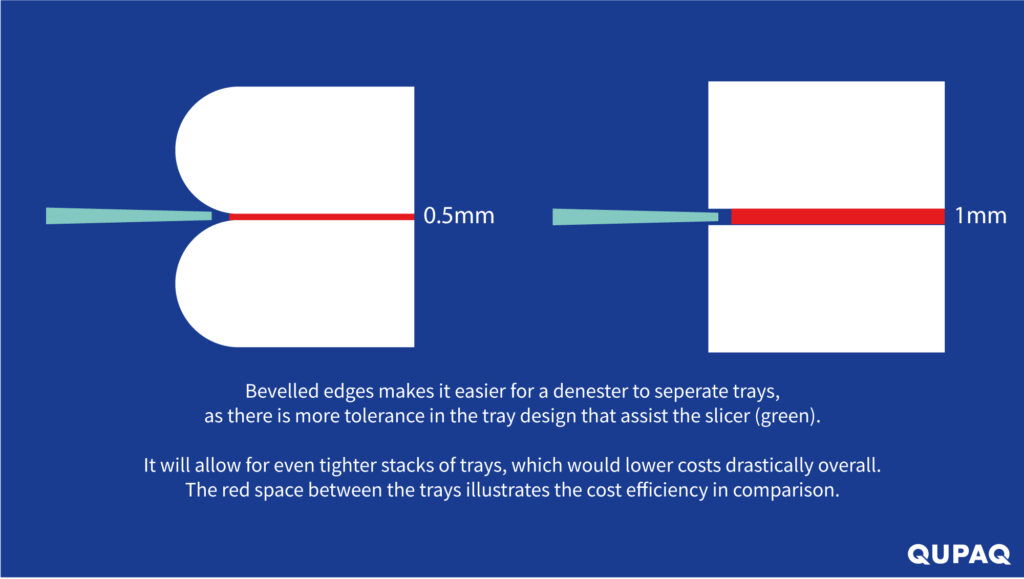
Basically, rounded edges on the trays allow for tighter nests. But trays rarely come with rounded edges, as most are vacuum-moulded and cut from a sheet.
It also comes down to the sturdiness and flexibility of the material. If the edge easily bends upon contact, this will also require a bigger gap. The more the tray edge can flex the more risk is involved. It may be preferrable in some cases to bend the edge and compress it to make it sturdy, predictable and secure for a slicer.
The Gap
Another thing that can be a cause of inreliability is the gap between the nested trays. Is it predictable or is there a lot of variance min/max in a nest? If the threshold is too big the denester will need to evaluate the nest with added sensors or vision-technology. Or perhaps even compress the nest even further for it to become a more reasonable pattern.
In theory, the gap could be as little as the material thickness itself. In reality, there will always be air involved somewhere in a nest of trays.
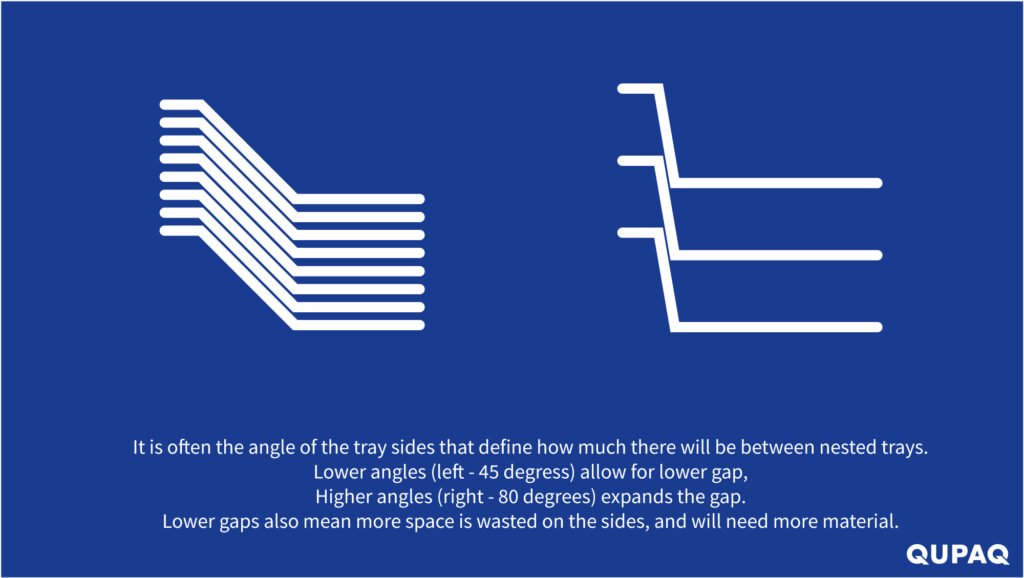
QUPAQ have seen nests, where the trays should be easy to denest, but the way the nests were stacked just made it too unpredictable to guarantee a reliable denesting. The choice of tray (or rather tray manufacturer) enforced added investments for custom denesting solutions, and lowered the degree of flexibility of the process. It was difficult to switch to other tray types/manufacturers on the same equipment.
As this is the physical world, there will be a need for tolerance to handle nests of trays. With beveled edges this tolerance can even be quite large, but we should always pursue nested trays are aligned somewhat even to reduce risk. And the design of the tray should allow for this in its entirety and not just the edge.
Food Goes in, Food Comes out
A lot of automation today is still logically built to replicate how a human would solve a process. We put food into trays and then we put the sealed trays into boxes for palletizing. There could be room for innovation in this field also, if we perceive it from a machine perspective rather than a human perspective.
One idea is instead of picking and placing the sealed trays into boxes, to somehow assemble the box around the trays after they are stacked. That could make the pick and place robot redundant, and the palletizing would use the same basic technology and precision as loading food intro trays. It could remove other processes on the line also for assembling cardboard boxes beforehand.
However, pick and place robots are a proven solution – QUPAQ also deliver solutions for handling processes – and innovating new optimizations must be funded before it can come of value to the industry. Even if its possible the research could become too expensive for it to come to fruition and return its own investment.
But if the research cost was shared within the value chain, beginning with the tray design and optimizing it for stacking, after the product is loaded and the tray is sealed, thinking outside the box (no pun intended), the tray may end up having new and different features that allow for a more optimal and risk-reduced handling process.
The Perfect Tray
It doesn’t exist. We will never reach a peaking point where we can claim a tray cannot be optimized further cost-effectively. Never. New market-demands and changes in our society will always push us to rethink how we do things currently and introduce new ways of improvements.
If we continue to use the status quo as a starting point for innovation – how we do it today – we will never truly be able to disrupt and bring major change into the mix. Design for Automation makes sense, and if it will allow for fewer processes, higher speeds and capacity, less cost for logistics and supply chains and reduce the risk of downtime significantly – not just slightly – we can evolve.
Innovation could begin with the tray design, looking for the best we can create currently. And when we have that, we make a new vision of the perfect tray. And rest assured – QUPAQ will be able to denest it and handle it all the way through the End-of-Line.


